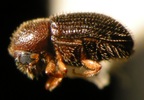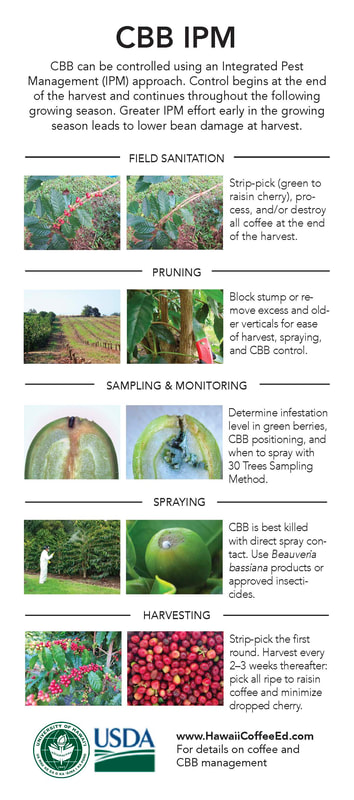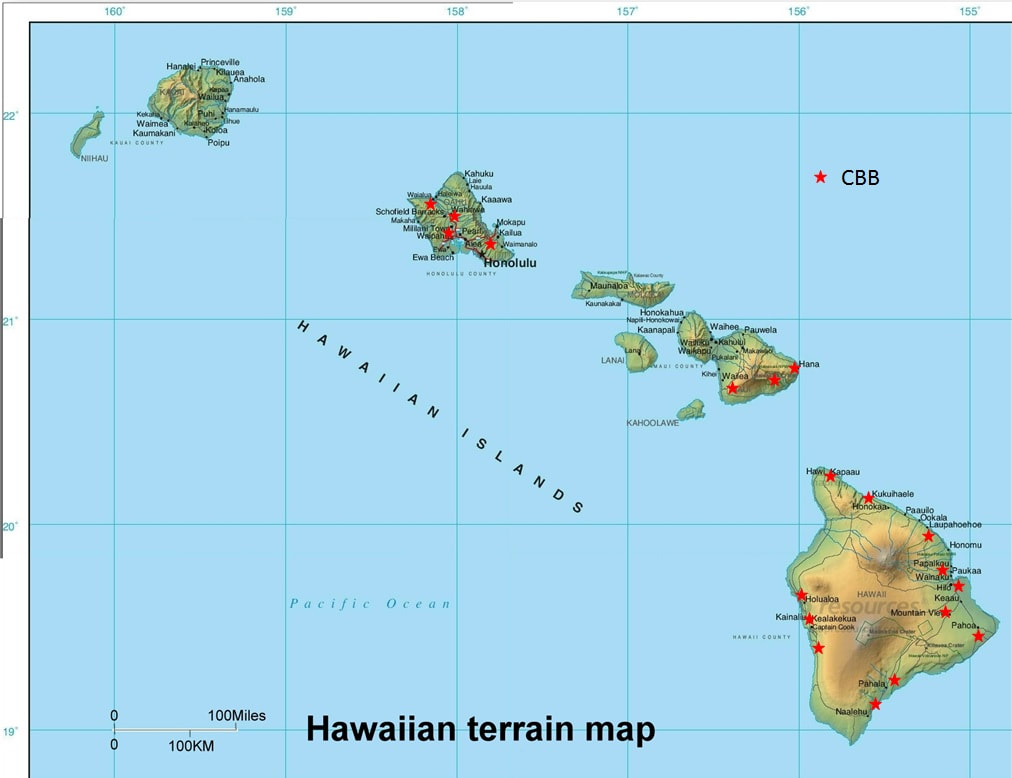|
|
|
Coffee Berry Borer and its Management
What is a Coffee Berry Borer? What is its history in Hawaii?
|
Coffee Berry Borer (CBB), Hypothenemus hampei, were first identified in Hawaii in August 2010. This beetle is considered one of the more important and devastating insect pests of coffee. CBB are currently found throughout Hawaii Island and on selected farms on Oahu and Maui. Learn more about CBB by clicking on the links below.
|
Managing Coffee Berry Borer on Your Farm
CBB can be controlled in Hawaii with proper farming and cultural control techniques otherwise known as integrated pest management (IPM). These IPM recommendations have been adapted from other regions of the world where CBB have been established for many years and where researchers and farmers have learned how to manage CBB effectively. Hawaii's scientists, extension agents, and other educational coordinators have used these techniques and technologies, as well as those developed in Hawaii, to educate farmers and processors on implementing CBB best management practices.
Click on the subject headings below to learn more about CBB IPM recommendations that farmers should employ on their farm. These are sections of the current recommendations that are found in the 2020 CBB IPM Recommendations document. This document has also been translated to Spanish. View and download "Recomendaciones para el manejo integrado de plagas de la broca del café en Hawái 2016" here.
Videos: CBB Management Techniques (2012)
|
English
|
Español
|
Video: Calibrating a Mist Blower Using the 1/128th Method
|
|
Save your $ and time. Instead of guessing the amount of product and water required for good spray coverage to control pests and diseases on your crop, UH CTAHR's Extension Agents on Oahu in collaboration with the UH IR-4 & Spray Coverage Program, developed a series of educational publications on the topic of spray calibration to address industry’s request for more resources on safe and effective crop protection chemical application. The 1/128th spray calibration method is a simple- to-use way to calibrate spray volume (gallons per acre rate). Basic math is needed to calculate acreage, spray solution/crop protection chemical requirements.
Calibrate using the 1/128th method:
|
Are you spraying Pyrethrin-based products that contain
Piperonyl Butoxide (PBO)?
(Posted 7/9/15)
Hawaii allows the use of Pyrethrin products that contain Piperonyl butoxide (PBO) to be sprayed on coffee as long as the product labels states that it is ok for use on coffee and label directions are followed. However, in recent months, Japan has stopped green coffee shipments from Hawaii due to the detection of PBO residues. The reason this is happening is because Japan does not have a Maximum Residue Level (MRL) published in Japan for PBO in coffee and the standard practice is then, to fall back to the 0.01 parts per million (ppm) measure.
If you are using products containing PBO and send coffee to Japan, please be aware of this situation and also highly encourage farmers to contact and talk to their processor before applying any products with PBO to coffee.
Hawaii allows the use of Pyrethrin products that contain Piperonyl butoxide (PBO) to be sprayed on coffee as long as the product labels states that it is ok for use on coffee and label directions are followed. However, in recent months, Japan has stopped green coffee shipments from Hawaii due to the detection of PBO residues. The reason this is happening is because Japan does not have a Maximum Residue Level (MRL) published in Japan for PBO in coffee and the standard practice is then, to fall back to the 0.01 parts per million (ppm) measure.
If you are using products containing PBO and send coffee to Japan, please be aware of this situation and also highly encourage farmers to contact and talk to their processor before applying any products with PBO to coffee.
Map of General CBB Infestations in Hawaii
Contact website management if you require any assistance with the site or information provided.



